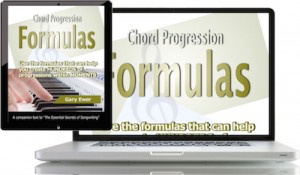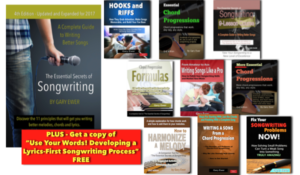In songwriting, you’re probably using a formula if you find yourself thinking, “After I write something like this, I should follow it up with something like that..” A songwriting formula is a way of simplifying the process, as well as giving your listeners something predictable.
The predictable nature of songwriting formulas is what songwriters dislike about them. It’s hard to be creative if you’re being predictable, at least to a certain extent.
 In songwriting, a chord progression formula is probably the safest kind of formula to use, and can add important strength to the structure of your music. Get “Chord Progression Formulas” as part of “The Essential Secrets of Songwriting 10-eBook Bundle”, or buy it separately.
In songwriting, a chord progression formula is probably the safest kind of formula to use, and can add important strength to the structure of your music. Get “Chord Progression Formulas” as part of “The Essential Secrets of Songwriting 10-eBook Bundle”, or buy it separately.
Having said that, it’s impossible to avoid using formulas. They’re part of pretty much any song you hear, no matter how innovative or creative they sound. Some common examples of what we do in songwriting that can be classified as formulaic — which, when not overused, can be the “pros” of using formulas, are:
- Using a verse-chorus-bridge (or any other commonly-used) design for your song.
- Using a standard chord progression that moves away from and back toward the tonic chord.
- Using melodies that are structured in and around the tonic note.
- Allowing musical energy to generally rise over the length of a song.
I want to make the case that songwriting formulas are not always bad. If you’re writing in any of the pop genres, such as folk, pop, rock, country, or any of their many sub-genres, it’s impossible to avoid all aspects of writing by formula.
The problem with formulas becomes apparent when you overuse them to the extent that you aren’t giving the audience much of anything that can be called innovative.
In that regard, formulas can be a good thing if, in the midst of a section of your song that sounds innovative (“strange”, your audience might call it), you revert to offering something more predictable and palatable. It’s a matter of balance.
Progressive rock gives us great examples of this toggling back and forth between unpredictable and predictable as a way of building musical trust between the songwriter and the listeners. A great example would be “The Gates of Delirium” by Yes, from their “Relayer” album of 1974.
Listen from the beginning, and make note of when you think that things sound chaotic or musically confusing to you, and then when things sound a bit more predictable, familiar and, in a certain way, comforting.
There is no way that anyone would accuse of Yes being anything close to predictable, or of using standard songwriting formulas. But there are moments within this work, as in the midst of all works, where formulas are in play.
The safest songwriting formulas to use in songs are chord progression formulas. That’s because no matter how predictable a chord progression is, you can still create innovative lyrics and melodies that pull focus away from those oft-used progressions.
So when is a songwriting formula dangerous? It’s really a matter of degrees. If you find that you’re always acquiescing to how you think your song should proceed at any given moment, you’re probably relying on formulas to get you through the song. Some common formulas that you need to watch for — the “cons” — are:
- Resorting to corny or often-used lyrics (“Every time I look at you..”, “back home before the dark..”, “burns like a flame”).
- Forcing rhymes.
- Using the same strumming rhythms, patterns and sounds in every song.
- Always falling back on the verse-chorus-bridge format.
 Written by Gary Ewer. Follow Gary on Twitter.
Written by Gary Ewer. Follow Gary on Twitter.
 “The Essential Secrets of Songwriting” eBook bundle includes“Writing a Song From a Chord Progression”. Discover the secrets of making the chords-first songwriting process work for you.
“The Essential Secrets of Songwriting” eBook bundle includes“Writing a Song From a Chord Progression”. Discover the secrets of making the chords-first songwriting process work for you.










